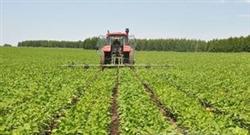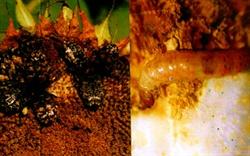Technical points of fertilizing soybean

The amount of soybean fertilizer should not be too much. Excessive application of base fertilizer will seriously affect seedling emergence and rooting. Planting fertilizer will cause serious damage to the radicle and Hypocotyl of soybean, and even cause some seeds can not germinate, chemical fertilizer and seeds should never be sowed into the soil at the same time. Due to excessive base fertilizer or topdressing, soybean will grow too much, or even lodge, resulting in reduced yield, therefore, soybean should not be over-fertilized. After applying fertilizer to soybeans, water supply must be ensured. If the water supply is not timely after fertilization, deep application will cause root damage; when surface application, it is easy to disperse in the sun and has no effect on soybean. The plant type of soybean varieties must be fully considered in fertilization. The varieties with tall plants must be suitable for sparse planting when they are cultivated with large fertilizer and high water. Otherwise, light ones will cause empty stalks to increase, while heavy ones will cause lodging and yield reduction. Fertilization should take into account soil fertility. When the soil fertility is high, little or no base fertilizer is applied. At the same time, tall varieties should also be sparsely planted and fertilized at the end of pod setting. Proper application of organic fertilizer, phosphorus and potassium fertilizer to summer soybean is very beneficial to cultivate strong soybean root system and increase root nodule. Therefore, soybean should apply more organic fertilizer, phosphorus and potassium fertilizer. It is best to combine organic fertilizer with phosphorus and potash fertilizer as base fertilizer, which can not only strengthen roots and stalks, but also make flowers and pods more and seeds full. Under general soil fertility, do not apply nitrogen fertilizer before and after the branching period of soybean. The experiment showed that the application of nitrogen fertilizer at the branching stage not only inhibited the growth and development of roots and nodules, but also turned flower buds into leaf buds, resulting in vigorous growth and reduced yield. Most experts at home and abroad believe that the yield of soybean can be increased by applying nitrogen fertilizer at flowering stage. The experiment shows that under the condition of general soil fertility, it is best not to apply nitrogen fertilizer at flowering stage. If the soil fertility is insufficient, the amount of nitrogen fertilizer applied at flowering stage should also be less, because the application of nitrogen fertilizer at flowering stage will cause serious shedding of buds and flowers. Topdressing nitrogen fertilizer at the end of pod setting can reduce blighted pods, greatly increase 100-seed weight, and make a small number of plants reproduce buds to form pods (mostly one or two pods), and increase the yield by 20% and 40%. Because the vegetative growth basically stopped at the end of podding, the growth rate of roots and nodules decreased greatly, and the nitrogen fixation ability of rhizobium decreased gradually at the grain filling stage. The amount of nitrogen and phosphorus absorbed by soybeans at the grain filling stage accounted for 60% to 65% of the total growth respectively, and the absolute amount of nitrogen needed was 9 times that of phosphorus. Therefore, it is common to feel that the supply of nitrogen is insufficient during the grain filling stage of soybean. Topdressing nitrogen fertilizer at the end of podding stage can not only meet the needs of soybean grain filling, but also will not cause plant growth, so it can greatly increase grain yield. Phosphorus deficient plots can also be topdressing with nitrogen and phosphorus. The suitable ratio of nitrogen to phosphorus is 9:1. After topdressing, we must pay attention to timely irrigation.
- Prev

Damage and control of sunflower white star flower golden turtle
The flower apparatus in which the adults feed on sunflowers, corn, vegetables and fruit trees. When damaging corn, adults eat filaments, damage sunflower plates, and cause sunflower plates to rot. The morphological characteristics of adults are 17-24mm in length and 9-12mm in width. Oval, with bronze or bronze color luster, body surface scattered with many irregular white velvet spots. Lips.
- Next

Safe use technology of pesticides in the production of high-oil soybean
Although soybeans can fix free nitrogen in the atmosphere by nodules, this accounts for only 30% to 50% of their needs, and the rest needs soil supply. Therefore, topdressing nitrogen fertilizer to soybean can strengthen stalk and branch, expand leaf area, enhance photosynthesis and improve stress resistance. Plots with poor soil fertility should be chased at the seedling stage.
Related
- The first cup of black tea in spring, the flavor and history of tea gardens in Kenya, Africa
- The computer can not only choose potatoes, but also grow tea rice. AI will grow winter oolong tea champion.
- It is not only the inflated tea bitten by insects, but also engraved with the four seasons tea in Beipu.
- The Oriental Beauty Tea Festival in Zhuxian County takes the stage at the weekend to experience the plus-size feast of oil tea.
- & quot; Oriental Beauty Tea & Exploration of Emei in Hsinchu, the hometown of quot;
- The new variety of strawberry "Tainong 1" dessert is the first choice with mellow aroma. Crimson gorgeous
- History of Tea in Taiwan: from Wild Inner Mountain to Export Tea Garden
- Two types of Taiwan Oriental Beauty Black Tea won the British three-Star Award for Childhood Tea Xiang Zhang Jiaqi changed from pilot to champion tea maker.
- Banana species and varieties: the planting history of Taiwan Xianren banana and dwarf banana is long, is banana disease resistant?
- Coffee planting Technology: Qianjie Coffee from Seedling to harvesting

